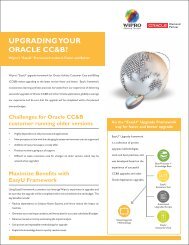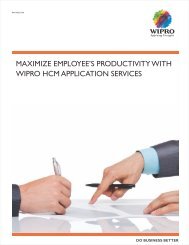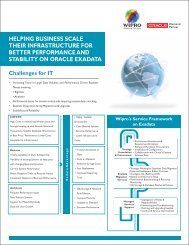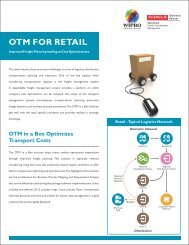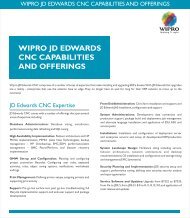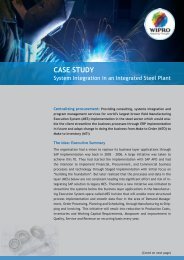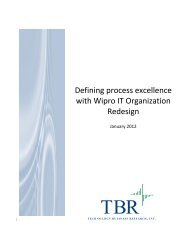Wipro Executive Summary
Wipro Executive Summary
Wipro Executive Summary
You also want an ePaper? Increase the reach of your titles
YUMPU automatically turns print PDFs into web optimized ePapers that Google loves.
Reaping the Benefits of<br />
Cloud Computing
Contents<br />
Introduction .................................................................................................................................................. 2<br />
Finding #1: Better alignment between business and IT is a strategic objective for many companies. ........ 4<br />
Finding #2: A majority of organizations are either planning to include cloud computing as part of<br />
their firm’s IT strategy – or have already implemented a cloud computing model ..................................... 6<br />
Finding #3: Reducing capital expenditure and maintenance costs is the key goal and objective for<br />
many organization’s cloud computing initiatives. ........................................................................................ 8<br />
Finding #4: Most survey respondents have invested in capacity expansion over the past three years. ... 10<br />
Finding #5: Data security is an important concern for most organizations. …………………….………..13<br />
Conclusion …………………………………………………………………………………………………….……………….………..16
Reaping the Benefits of Cloud Computing<br />
Introduction:<br />
In the current business environment, organizations are mandated to run lean and mean,<br />
holding down costs while maximizing the resources they have. Organizations must also hone<br />
their competitive edge with the ability to quickly deliver new products to market. An agile IT<br />
environment with operational flexibility can go a long way in helping companies successfully<br />
compete in the today’s highly-charged economic environment.<br />
Cloud computing, an Internet-based model for IT services consumption, supplementation and<br />
delivery, can be instrumental in assisting companies in dealing with today’s most pressing<br />
issues. It typically involves providing dynamically scalable and often virtualized resources as a<br />
service over the Internet. Cloud computing providers normally deliver business applications<br />
online, making them readily available via a Web browser. Software and data are stored on<br />
servers.<br />
Because they only pay for what they actually use, organizations that implement the cloud<br />
computing model avoid the substantial upfront investment in hardware, software and related<br />
services. Resource consumption is typically billed or available by subscription. Cloud’s many<br />
benefits include dramatically reduced costs, low management and maintenance requirements,<br />
and immediate access to a variety of applications.<br />
In addition, cloud delivers computing capacity to organizations quickly and on an as-needed<br />
basis. Conversely, cloud can enable organizations to scale back as their business needs change.<br />
This ‘elasticity’ is an important feature for organizations that don’t want to commit to the full<br />
capacity they want today but desire to stay poised for the future ebb and flow of business<br />
demands.<br />
Cloud’s major benefits include:<br />
• Agility, since users can quickly and inexpensively provision infrastructure resources on an asneeded<br />
basis;<br />
• Reduced cost, lowering barriers to entry and making it unnecessary for firms to make major<br />
investments in infrastructure;<br />
• Anytime/Anywhere access, because services are delivered over the Internet;<br />
3 | P a g e
Reaping the Benefits of Cloud Computing<br />
• Scalability, which enables users to ramp up in times of greater demand, and scale down when<br />
demand abates;<br />
• Reliability, due to cloud computing delivery using multiple sites;<br />
• Sustainability, from improved resource utilization and more efficient systems; and<br />
• Lower maintenance, since applications are not installed on every computer in an<br />
organization.<br />
Outsourcing Center and <strong>Wipro</strong> performed a survey that aimed to determine views and opinions<br />
on cloud computing of companies from various industry segments. While not a comprehensive<br />
picture of how these organizations are approaching cloud computing, the survey results identify<br />
some general trends in this emerging area. Survey respondents were from retail, financial<br />
services, transportation/logistics, manufacturing, healthcare, telecommunications and other<br />
industries.<br />
How does cloud computing fit into your company’s overall IT strategy?<br />
4 | P a g e
Reaping the Benefits of Cloud Computing<br />
Finding #1: Better alignment between business and IT is the number one<br />
strategic IT objective for many companies.<br />
What are your strategic IT objectives?<br />
Better business-IT alignment<br />
Cost reduction<br />
Increased availability and reliability<br />
Outsourcing<br />
Other<br />
Today's business organizations are increasingly reliant on IT to achieve business growth and<br />
drive innovation in their processes. Given the turbulent economy and increasing pressures to<br />
reduce costs and use fewer resources while meeting tighter deadlines, it’s become imperative<br />
for IT to be more agile in responding to business opportunities and for IT managers to drive<br />
innovation. Organizations that are able to align business and IT will be more efficient and<br />
effective in delivering products and services. They will also excel in lowering costs while<br />
increasing opportunity for new revenue and product opportunities.<br />
Given this scenario, it is expected that in the near future almost all IT infrastructure layers will<br />
be more directly driven by business processes. Enterprises have started to seriously consider<br />
cloud computing as an answer to challenges ranging from managing the enterprise IT<br />
infrastructure economically to improving employee productivity.<br />
Cloud computing enables businesses to reduce costs and improve service levels. A major aspect<br />
of on-demand cloud computing is that it helps companies to respond with flexibility and speed<br />
to any customer demand, market opportunity or external threat. Furthermore, cloud<br />
11%<br />
31%<br />
42%<br />
51%<br />
57%<br />
5 | P a g e
Reaping the Benefits of Cloud Computing<br />
computing enables customers to access all of their documents and data from any device (the<br />
home or work PC, the mobile phone, an internet point), as they already do for email services or<br />
social networks – thus enhancing business efficiency.<br />
According to the <strong>Wipro</strong> and Outsourcing Center survey, a majority of firms are striving to more<br />
closely align business and IT functions. In fact, more than half (56.7%) of respondents said that<br />
better business-IT alignment was among their strategic IT objectives. Also important to survey<br />
respondents is reducing costs, as 51.1 percent of participants identified cost reduction as a<br />
strategic IT objective. Respondents also said their companies were interested in increasing<br />
availability and reliability (42.2%) and outsourcing (31.1%).<br />
Says RamPrasad Kan, Chief Technologist at <strong>Wipro</strong> Technologies, other considerations are<br />
important as well. “In this market, cost savings and resource optimization are critical,” says Kan.<br />
“For lines of business, a top priority is the ability to quickly bring new products and services to<br />
market. And cloud can deliver all these benefits.”<br />
6 | P a g e
Reaping the Benefits of Cloud Computing<br />
Finding #2: A majority of organizations are either planning to include cloud<br />
computing as part of their firm’s IT strategy – or have already implemented a<br />
cloud computing model.<br />
Is cloud computing part of your current IT strategy? OR Have you<br />
implemented cloud computing?<br />
No<br />
29%<br />
Cloud computing is a model that’s beginning to enjoy widespread adoption. The majority of<br />
<strong>Wipro</strong>-Outsourcing Center survey respondents report that they are either now including cloud<br />
computing in their current IT strategy, or they’ve used it in the past. In fact, nearly threefourths<br />
(71.4%) of survey participants are currently using cloud computing or have used it<br />
previously. Only just more than one-fourth (28.6%) are not now using cloud and have not used<br />
this model in the past.<br />
The benefits of cloud computing are many, but optimization of resource utilization was the<br />
reason half of survey respondents said that they chose it.<br />
• Less than one-fifth (19.7%) of respondents said that cloud’s cost advantage was the number<br />
one reason they chose this model.<br />
• Only 9.1 percent said that simplified usage for end users was their reason for going with<br />
cloud.<br />
71%<br />
Yes<br />
7 | P a g e
Reaping the Benefits of Cloud Computing<br />
• A scant 3.0 percent cited remote access through the Internet as their reason for<br />
implementing cloud computing.<br />
• Almost half (47.3%) of survey participants said that cloud computing is central to their overall<br />
IT strategy.<br />
For the most part, those whose organizations haven’t implemented cloud computing said that<br />
their hesitance was due to the immaturity of the cloud computing model, or that they weren’t<br />
sufficiently informed of the real benefits that cloud computing could deliver to their<br />
organization. Others are considering implementing the cloud computing model in the future.<br />
According to <strong>Wipro</strong>’s Kan, firms that haven’t yet looked to cloud computing might want to revisit<br />
their strategy.<br />
“Most companies already are adopting cloud in some manner because the benefits seem to be<br />
very obvious, and they were waiting for the early adopters who have been using cloud for a<br />
while now,” he points out. “So companies are now implementing cloud at an impressive rate.”<br />
Cloud computing services include: Infrastructure as a Service (IaaS), which provides virtual<br />
servers with unique IP addresses and blocks of storage on demand; Platform as a Service (PaaS),<br />
a group of software and development tools that are hosted on the service provider’s servers;<br />
and Software as a Service (SaaS), where the outside vendor provides access to a wide variety of<br />
applications.<br />
Says Kan, small and large businesses generally differ in their cloud usage. A small business<br />
wants to take everything from the cloud – infrastructure, platform and applications, he says.<br />
“But most large enterprises will go the hybrid route, with some things in-house and others from<br />
the cloud, while smaller businesses will take advantage of the entire stack of offerings from the<br />
public cloud.”<br />
8 | P a g e
Reaping the Benefits of Cloud Computing<br />
Finding #3: Reducing capital expenditure and maintenance costs is the key goal<br />
and objective for many organization’s cloud computing initiatives.<br />
What are the three key goals and objectives for your current or planned<br />
cloud computing initiative?<br />
Reduced Capital Expenditure and<br />
maintenance costs<br />
Better pooling of resources and<br />
superior performance<br />
Increased availability<br />
Other<br />
Cloud computing provides enterprises a choice of a subscription payment model or migration of<br />
their multiple workloads onto shared IT infrastructures, either private or public clouds. In<br />
financial terms, this enables a company to be cost efficient by transforming the bulk of its<br />
infrastructure costs from being a capital expenditure to an operating expenditure, while<br />
simultaneously achieving high levels of consolidation and IT automation.<br />
By offering self-service system interfaces to the users, cloud computing simplifies system<br />
usability. Customers are freed from the hassles associated with developing applications, backend<br />
engineering and maintaining the server. In short, users just pay and use the application<br />
services without having to bother with operation, software maintenance or application support<br />
functions. This further helps reduce costs.<br />
In addition, cloud computing is based on an integrated platform of infrastructure, platform and<br />
software, resulting in economies of resources and costs. Pooling resources by multiple<br />
companies leads to superior performance of the complete system. The load is effectively<br />
managed from a single central source and the server uses full capacity. This is a win-win<br />
situation for both the host and the users. Thus, cloud computing results in improved resource<br />
consumption and is extremely cost effective.<br />
24%<br />
44%<br />
60%<br />
75%<br />
9 | P a g e
Reaping the Benefits of Cloud Computing<br />
In the <strong>Wipro</strong> and Outsourcing Center survey, a full three-fourths of responding organizations<br />
noted the most important objective for their current or planned cloud computing initiative is<br />
reducing capital expenditure and maintenance costs. More than half (59.7%) identified better<br />
pooling of resources and superior performance as key objectives. And increased availability was<br />
also flagged as a key goal for organizations’ cloud efforts.<br />
“Cloud can help ensure that organizations have an agile IT environment with true operational<br />
flexibility,” Kan explains. “And savings can be considerable with the cloud computing model.”<br />
But cloud can also deliver best-of-breed applications, apps that CIOs want to deploy but don’t<br />
want to spend a lot of time developing. “Firms can get these applications from a cloud service<br />
provider without having to develop them and without having to manage them. With cloud, you<br />
don’t have to manage the infrastructure in a discrete manner. Instead, you can consolidate and<br />
optimize your infrastructure very effectively,” says Kan.<br />
10 | P a g e
Reaping the Benefits of Cloud Computing<br />
Finding #4: Most survey respondents have invested in capacity expansion over<br />
the past three years.<br />
Have you invested in capacity expansion over the past three years?<br />
No<br />
15%<br />
Due to the rapid growth in services, it has become vital for companies to scale up their IT<br />
infrastructure and invest in capacity expansion to meet increasing customer demands.<br />
Companies need a cost-effective way to achieve this objective without risking over<br />
provisioning their networks or data centers.<br />
For instance, when enterprises have expansion plans across geographies or growth of business<br />
units, they automatically need a big IT back end. In addition, the huge backlog of data<br />
accumulated in the process would require a heavy IT infrastructure investment to sufficiently<br />
process and store that massive data, while still being able to offer effective services to<br />
customers.<br />
Shifting to the cloud can enable the organization to host data on an external platform while<br />
still providing the necessary services to customers. Also in situations where there is a shortterm<br />
requirement that heavily relies on a large IT back end, a company can opt for a cloud<br />
rather than investing unjustified sums to acquire new infrastructure for a short-lived need.<br />
85%<br />
Yes<br />
11 | P a g e
Reaping the Benefits of Cloud Computing<br />
Cloud computing provides the resources on-demand for many typical scaling points that a Web<br />
application needs, including servers, storage and networking. The on-demand nature of cloud<br />
computing combined with the pay-as-you-go model means that when a company requires<br />
more capacity during a peak season or to match its growth, it simply pays for it on demand.<br />
Similarly, when a business slows down and a company needs less capacity, it just uses (and<br />
pays) for the resources as required. In a nutshell, cloud offers nearly unlimited capacity and<br />
agility giving enterprises the ability to add or subtract servers while taking advantage of the<br />
cloud’s on-demand pricing. Cloud computing can enable enterprises to deploy on-demand<br />
scaling according to the fluctuation of business traffic.<br />
An overwhelming majority of respondents to the <strong>Wipro</strong> and Outsourcing Center survey said<br />
that their organizations had invested in capacity expansion over the past three years.<br />
84.6 percent said that their organizations had invested in capacity expansion over the past<br />
three years<br />
15.4 percent had not invested in capacity expansion<br />
25 percent said that their firm’s current IT infrastructure utilization rates were less than 30<br />
percent<br />
34.2 percent said their firm’s IT infrastructure utilization rates were in the 30 percent to 50<br />
percent range.<br />
40.8 percent of respondents said that in their firm, these rates were in the 50 percent to 75<br />
percent range.<br />
Capacity management impacts all IT organizations. It’s critical to predict the kind of demand<br />
users typically face and also have the ability to increase capacity as quickly as possible.<br />
12 | P a g e
Reaping the Benefits of Cloud Computing<br />
“Speed has become the top-of-mind advantage today,” Kan says. “The faster you can deliver<br />
capacity to business, the easier you can innovate, introduce new services and take a new<br />
product or service to market.”<br />
To get computer capacity for a project team may involve a 45-day cycle. With cloud, the cycle<br />
time is reduced to a mere 45 minutes. “With cloud, users can log in and get the capacity they<br />
need. And in addition, organizations add more control to their IT infrastructure,” Kan notes.<br />
13 | P a g e
Reaping the Benefits of Cloud Computing<br />
Finding #5: Data security is a big concern for most organizations.<br />
How much importance do you place on data security? Rate on a scale<br />
from 1 to 5 where 1 is very important and 5 is not important.<br />
3<br />
2<br />
4<br />
3%<br />
14%<br />
14%<br />
5<br />
9%<br />
There are several security concerns that have been raised related to cloud computing.<br />
However, these issues can be managed competently with effective data safeguarding<br />
measures in the cloud.<br />
According to Gartner, Cloud computing has "unique attributes that require risk assessment in<br />
areas such as data integrity, recovery and privacy, and an evaluation of legal issues in areas<br />
such as e-discovery, regulatory compliance and auditing." It is important for cloud providers to<br />
ensure greater control of hosting and accessing services and applications in the cloud. By<br />
taking on this significant responsibility, they will be able to assure customers of data security in<br />
the cloud.<br />
Cloud providers should follow similar protection measures for cloud infrastructure security as<br />
they do for their physical assets in their internal data center. All data access in the cloud<br />
should be mediated through a proactive security control that can monitor and block malicious<br />
or inappropriate use. Firewalls and data leakage prevention appliances can be applied in a<br />
virtual environment to monitor and maintain the same level of security. The standard defense<br />
60%<br />
1<br />
14 | P a g e
Reaping the Benefits of Cloud Computing<br />
– an in-depth approach of deploying multiple technologies to detect and defend against<br />
attacks on sensitive data – is essential.<br />
Cloud providers should also have an appropriate disaster recovery and business continuity<br />
processes in place to meet customers’ business needs. With a disaster recovery plan, vendors<br />
can replicate the data and application infrastructure across multiple sites in the case of a<br />
failure, providing customers with the necessary data backup.<br />
Regulatory compliance is another important aspect that providers need to fulfill. The cloud<br />
provider must have the necessary policies, processes and procedures in place to properly<br />
maintain those security controls. These principles should ensure that there is transparency<br />
over how data is protected. Cloud providers should maintain a comprehensive security<br />
program and should disclose whether their security efforts meet security standards.<br />
In a nutshell, vendors need to have these security steps in place and follow a transparency<br />
approach with customers. In this way, customers are aware of the data assets they are putting<br />
into a cloud and can work together with the vendor to ensure the control policies match the<br />
legal requirements of that data and ensure they are able to reclaim their documents and data<br />
in the case of a security attack.<br />
Nearly three-fourths (74.4%) of all respondents to the <strong>Wipro</strong>-Outsourcing Center survey said<br />
that data security was either a major concern or of considerable importance for their<br />
organization. Only 14.1 percent said that data security was not important for their firm.<br />
Security concerns vary depending on the type of cloud used by an organization. Services<br />
delivered via Public Cloud are provided over the Internet through a Web application or Web<br />
services from an off-site, third-party provider. A private cloud emulates cloud computing but<br />
actually delivers services through private networks. Private clouds provide a greater level of<br />
security. Many organizations use what are called hybrid clouds. A hybrid cloud environment<br />
uses multiple and internal and external providers, or public and private clouds, enabling<br />
15 | P a g e
Reaping the Benefits of Cloud Computing<br />
enterprises to receive less sensitive information and services through the public cloud and<br />
their more sensitive information through a private cloud.<br />
Explains <strong>Wipro</strong>’s Kan, the data security issue can be handled with a combination of technology<br />
and process. “There are processes that must be put in place before an enterprise can adopt a<br />
public cloud and manage the data efficiently,” he points out. “These are the kind of services<br />
<strong>Wipro</strong> can provide in terms of determining how a public cloud is being used by an enterprise,<br />
monitoring on a continuous basis and assuring that data is secure and not left open.”<br />
Conclusion:<br />
Cloud computing can provide benefits to organizations of all sizes and from all industry<br />
segments. Cloud’s many benefits include agility, reduced cost, access to services anytime,<br />
anywhere; scalability that enables users to ramp up – or down – as demand surges or wanes;<br />
and lower maintenance requirements. Cloud enables optimization of resources and<br />
unprecedented speed in increasing computer capacity, enabling businesses to innovate and<br />
get products to market in a timely manner.<br />
<strong>Wipro</strong>’s solutions and services extend across the various cloud layers, from Business Process as<br />
a Service, Software as a Service, and Platform as a Service to Infrastructure as a Service.<br />
Whatever the client’s strategy for cloud adoption, <strong>Wipro</strong> has the expertise, experience and<br />
integrated solutions to match clients’ requirements.<br />
<strong>Wipro</strong> believes that enterprise IT -- applications, platforms, infrastructure, business process --<br />
will be a hybrid of traditional on-premise , private cloud and public cloud services. Enterprises<br />
will potentially consume cloud services from multiple public cloud service providers and also<br />
consolidate internally through private clouds. <strong>Wipro</strong>'s is a trusted partner able to integrate<br />
public and private cloud services for an enterprise to create an agile and business-oriented IT.<br />
<strong>Wipro</strong> can also create a portfolio of industry-specific business process solutions delivered as<br />
cloud services from public cloud platforms and its own data centers.<br />
<strong>Wipro</strong>’s cloud services portfolio helps address two key customer objectives:<br />
Build, operate and manage enterprise private cloud environments<br />
Adopt hybrid cloud delivery models by helping customers integrate cloud services into<br />
their IT portfolio and manage IT as a service for on- and off-premise infrastructure and<br />
applications<br />
16 | P a g e
Reaping the Benefits of Cloud Computing<br />
<strong>Wipro</strong> offers a portfolio of <strong>Wipro</strong>-branded cloud services to its customers, catering to both<br />
horizontal and industry-specific applications. <strong>Wipro</strong>’s services ride on a strong R&D backbone<br />
consisting of 18 cloud centers of excellence, ably supported by a robust partner ecosystem<br />
integrating best-of-breed cloud solutions from key industry players. The firm’s unique, nonintrusive<br />
cloud discovery consulting service, combined with replicable solutions and<br />
frameworks, have made <strong>Wipro</strong> the partner of choice for more than 150 cloud customers<br />
around the world. Driven by a strong global presence and with established practices across<br />
various industry verticals, <strong>Wipro</strong> helps organizations adopt cloud dynamically, effectively and in<br />
a scalable and sustainable model.<br />
About the Survey Respondents:<br />
A full 40 percent of survey participants are employed at firms with fewer than 1,000 employees.<br />
More than a third (36.7%) work for large enterprises with more than 20,000 people employed.<br />
The remaining 22.4 percent said their firms employed more than 1,000 individuals but fewer<br />
than 20,000 people. More than half (50.6%) of respondents said their company’s annual<br />
revenue is greater than $300 million, while just more than one-quarter (27.5%) of participants<br />
said their firm’s annual revenue is less than $20 million. More than half (56.8%) of survey<br />
participants responded that their IT budget for 2009 was more than $10 million, with 42.0<br />
percent of respondents’ companies operating with an IT budget of more than $50 million for<br />
the past year.<br />
ABOUT WIPRO TECHNOLOGIES<br />
<strong>Wipro</strong> is the first PCMM Level 5 and SEI CMMi Level 5 certified IT Services Company globally.<br />
<strong>Wipro</strong> provides comprehensive IT solutions and services (including systems integration, IS<br />
outsourcing, package implementation, software application development and maintenance)<br />
and Research & Development services (hardware and software design, development and<br />
implementation) to corporations globally.<br />
<strong>Wipro</strong>'s unique value proposition is further delivered through its pioneering Offshore<br />
Outsourcing Model and stringent Quality Processes of SEI and Six Sigma.<br />
17 | P a g e
Reaping the Benefits of Cloud Computing<br />
ABOUT WIPRO Council for Industry Research<br />
The <strong>Wipro</strong> Council for Industry Research comprising of domain and technology experts from<br />
the organization aims to address the needs of customers by specifically looking at innovative<br />
strategies that will help them gain competitive advantage in the market. The Council, in<br />
collaboration with leading academic institutions and industry bodies, studies market trends to<br />
equip organizations with insights that facilitate their IT and business strategies<br />
For more information please visit www.wipro.com/industryresearch.<br />
ABOUT Outsourcing Center<br />
Outsourcing Center is the most prominent Internet portal for thought leadership, best<br />
practices, emerging trends, and strategies for successful sourcing. In addition, since 1997 we<br />
have recognized the world’s best outsourcing relationships through the annual Outsourcing<br />
Excellence Awards program. As the resource for actionable business insights, Outsourcing<br />
Center provides objective perspectives and real-world examples, identifies business risks, and<br />
explains how to leverage value-creation opportunities. The Center’s parent company is Everest<br />
Group, an advisor to business leaders on global services with a worldwide reputation for<br />
helping Global 1000 firms dramatically improve their performance by optimizing their back- and<br />
middle-office business services. For more information, contact Peter Bowes at<br />
pbowes@outsourcingcenter.com<br />
18 | P a g e




